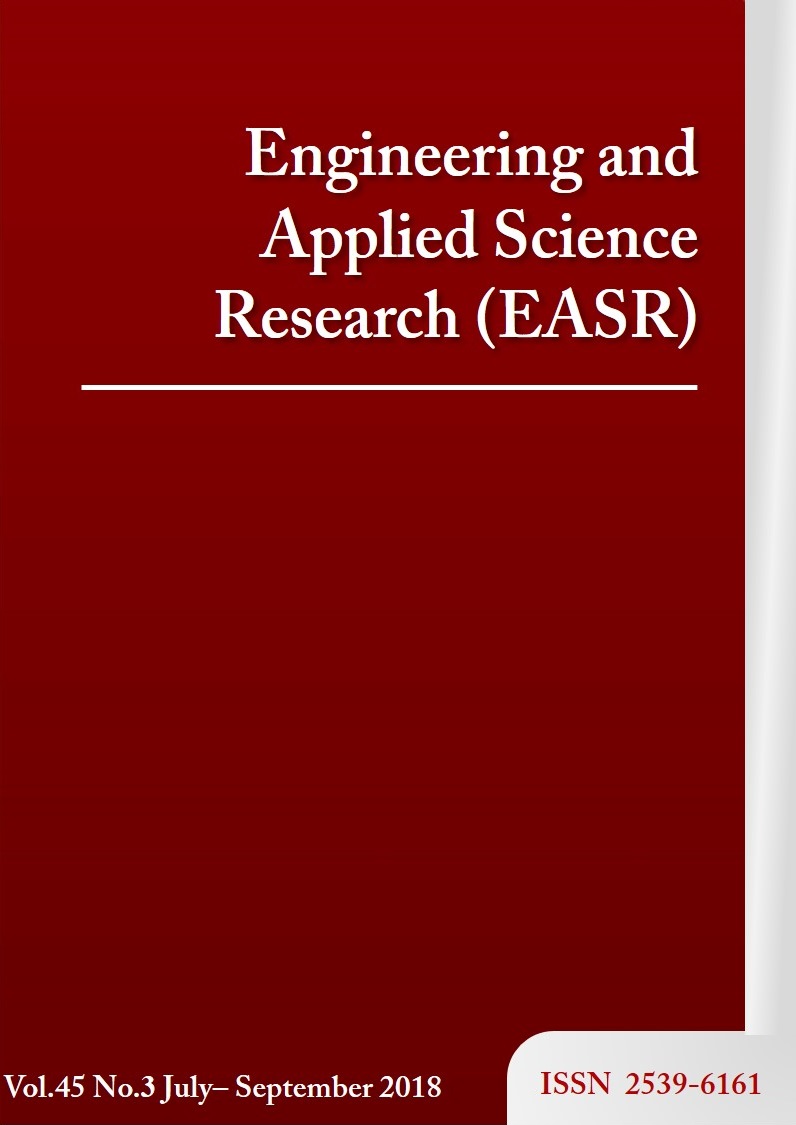Development of frame finite element model for truss structures with semi-rigid connections
Main Article Content
Abstract
The problem of connecting truss structures is one of the major concerns in structural analysis and design. The behavior of truss structures is usually analyzed using a common finite element model, which considers each member as a two-force member. Each truss member connection is treated as a rotational pinned joint, but in the reality, the members of truss structures are usually connected with bolts or by welding. Alternatively, a designer may analyze such a structure using a frame finite element model where joint connections are considered fixed or rigid connections, which provide a connection that is stiffer than the inherent behavior. In this research, instead of using truss or frame finite element models, a substructure technique is employed to develop a more realistic finite element model. Each element is separated into three parts, a main element and two joint elements. The substructure technique is integrated into the frame finite element model to reduce design variables in global equations, to increase deformability of the joint elements, and make the proposed model more realistic. Young’s modulus values of the joints are reduced as a percentage of the modulus of the main elements. Comparison of the results obtained from the proposed model to the truss and frame finite element models are reported.
Article Details
This work is licensed under a Creative Commons Attribution-NonCommercial-NoDerivatives 4.0 International License.
References
[2] Sae-Lee D, Sosakul T, Hovichitr W, Suriyawanakul J, Poovarodom P, Bumrungsiri W, Pongkornkumpon S, Supasatean W. Three dimensional finite element analysis of mandibular premolar restored with fiber post and resin composite with different cavity designs. KKU Eng J. 2016;26;43(4):196-203.
[3] Tejani GG, Savsani VJ, Patel VK. Adaptive symbiotic organisms search (SOS) algorithm for structural design optimization. J Comput Des Eng. 2016;3(3):226-49.
[4] Tejani GG, Savsani VJ, Bureerat S, Patel VK. Topology and size optimization of trusses with static and dynamic bounds by modified symbiotic organisms search. J Comput Civ Eng. 2017;32(2):1-11.
[5] Tejani GG, Savsani VJ, Patel VK, Mirjalili S. Truss optimization with natural frequency bounds using improved symbiotic organisms search. Knowl Base Syst. 2018;143:162-78.
[6] Savsani VJ, Tejani GG, Patel VK. Truss topology optimization with static and dynamic constraints using modified subpopulation teaching–learning-based optimization. Eng Optim. 20161;48(11):1990-2006.
[7] Reddy JN. An introduction to the finite element method. New York: McGraw-Hill; 1993.
[8] Rao SS. The finite element method in engineering. 6th ed. UK: Butterworth-heinemann; 2017.
[9] Lui EM, Chen WF. Analysis and behaviour of flexibly-jointed frames. Eng Struct. 1986;8(2):107-18.
[10] Suarez LE, Singh MP, Matheu EE. Seismic response of structural frameworks with flexible connections. Comput Struct. 1996;58(1):27-41.
[11] Hadianfard MA, Razani R. Effects of semi-rigid behavior of connections in the reliability of steel frames. Struct Saf. 2003;25(2):123-38.
[12] Saritas A, Koseoglu A. Distributed inelasticity planar frame element with localized semi-rigid connections for nonlinear analysis of steel structures. Int J Mech Sci. 2015;96:216-31.
[13] Ozel HF, Saritas A, Tasbahji T. Consistent matrices for steel framed structures with semi-rigid connections accounting for shear deformation and rotary inertia effects. Eng Struct. 2017;137:194-203.
[14] Da Silva JG, De Lima LR, Vellasco PD, De Andrade S, De Castro RA. Nonlinear dynamic analysis of steel portal frames with semi-rigid connections. Eng Struct. 2008;30(9):2566-79.
[15] Hadianfard MA, Rahnema H. Advanced nonlinear time-history analysis of partially restrained steel frames by using integrated equations of motion. In: Tizani W, Editor. Proceedings of the International Conference on Computing in Civil and Building Engineering; 2010 Jun 30-Jul 2; University of Nottingham, UK. UK: Nottingham University Press; 2010. p. 1-7.
[16] Galvão AS, Silva AR, Silveira RA, Gonçalves PB. Nonlinear dynamic behavior and instability of slender frames with semi-rigid connections. Int J Mech Sci. 2010;52(12):1547-62.
[17] Minghini F, Tullini N, Laudiero F. Vibration analysis of pultruded FRP frames with semi-rigid connections. Eng Struct. 2010;32(10):3344-54.
[18] Al-Aasam HS, Mandal P. Simplified procedure to calculate by hand the natural periods of semirigid steel frames. J Struct Eng. 2012;139(6):1082-7.
[19] Nguyen PC, Kim SE. Nonlinear elastic dynamic analysis of space steel frames with semi-rigid connections. J Constr Steel Res. 2013;84:72-81.
[20] Reyes-Salazar A, Bojórquez E, Haldar A, López-Barraza A, Rivera-Salas JL. Seismic response of 3D steel buildings considering the effect of PR connections and gravity frames. Sci World J. 2014 ;2014:1-13.
[21] Lyu N, Saitou K. Decomposition-Based assembly synthesis for structural stiffness. J Mech Des. 2003;125(3):452-63.
[22] Lyu N, Saitou K. Topology optimization of multicomponent beam structure via decomposition-based assembly synthesis. J Mech Des. 2005;127(2) :170-83.
[23] Hansen SD, Anderton GL, Connacher NE, Dougherty CS. Analysis of the 747 aircraft wing-body intersection. New York: Air Force Institute of Technology; 1968. Report No.: AFFDL TR 68-150.
[24] Stasa FL. Applied finite element analysis for engineers. USA: Oxford University Press; 1985.
[25] Kohnke P. Ansys engineering analysis system theoretical manual. 3rd ed. Houston: Swanson analysis system; 1986.
[26] Bureerat S, Pholdee N. Optimal truss sizing using an adaptive differential evolution algorithm. J Comput Civ Eng. 2015;30(2):04015019.


